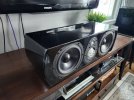I should point out that just because you can see it on measurements, it does not mean it will sound bad. My advice is to pull your speaker to the front of the shelf and have a listen. I doubt it will sound substantially better than where you have it at the moment. Then you can push it back to where it is and sleep in peace.
Agreed. The ears do not necessarily process sound the same way the eyes process a frequency response graph.
Comb filter effects in particular can look horrendous on paper while being innocuous to the ear.
And one potential downside of using aggressive absorption there is, the short wavelengths will be removed from that sound but the long wavelengths remain, so THAT reflection energy now has a significantly degraded spectral balance.
Last edited:

